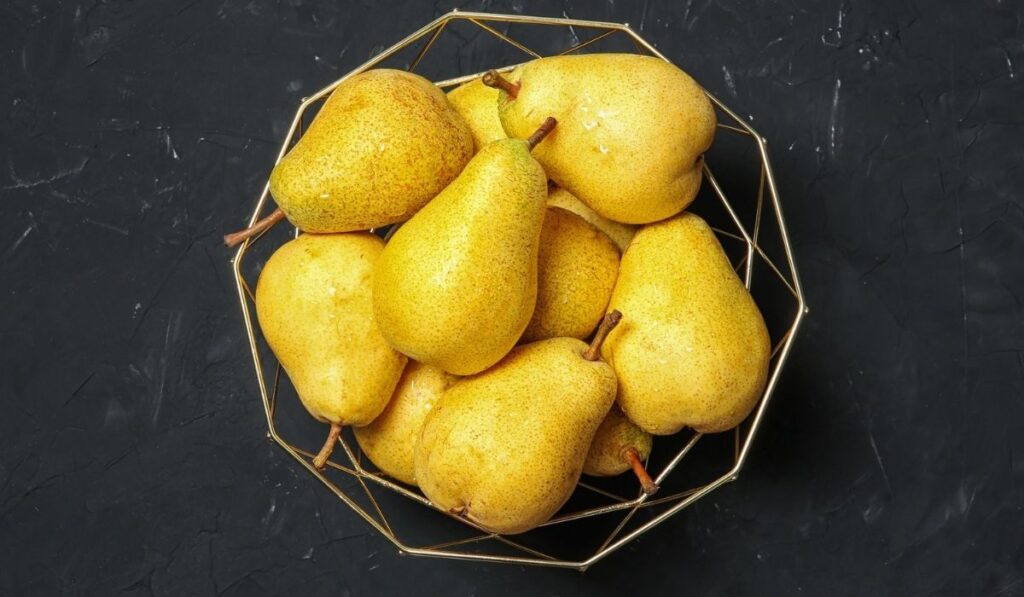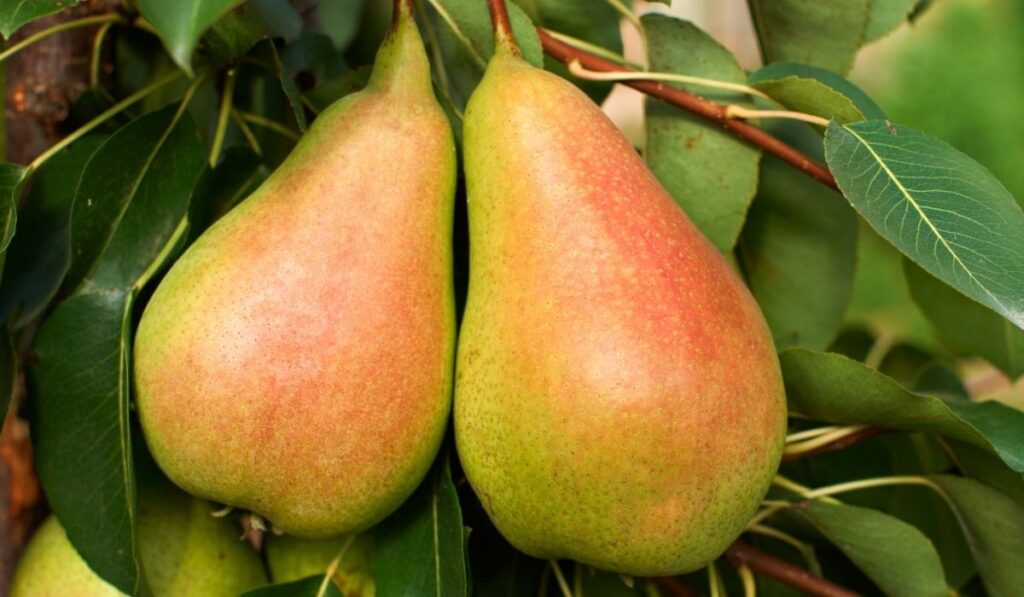Pears are a tasty and versatile fruit that’s especially popular in autumnal recipes. There are a handful of different species of pear that vary in shape, color, and texture. So, when can you get the best pears?
Most pear species are available from August to October. You can expect fresh pears to appear in the market around early autumn. In order to know when a pear is ripe, press the stem end. If it feels slightly soft, it’s probably ready to eat.
Let’s take a closer look at the various kinds of pears, when they’re in season, and how to store and use them.
What Types of Pears Are There?

Pears grow in various regions all over the world and comes in many types, all with different shapes, sizes, and flavors. Below are eight different types of pears:
1. Anjou Pears
This egg-shaped pear originated in Belgium. The Anjou pear variety comes in green and red. They’re available year-round, but the peak season runs from late fall through winter.
2. Bartlett Pears
Bartlett pears are the most popular pear variety in the United States. This pear comes in both a green and red color. Bartlett pears have a classic pear flavor and soft flesh. Bartlett pears are available from August to December.
3. Comice Pears
Although Comice pears come in various sizes, you can easily distinguish them by their round body and short neck. They have a fruity flavor and a finer texture than other pears varieties. Comice pears are available from September to February.
4. Bosc Pears
Bosc pears are sweet and succulent. This pear has a bronze skin with a long neck, making it easy to differentiate them. Bosc pears reach markets from late September to April.
5. Concorde Pears
Concorde pears are a very sweet variety of pear. They have bright green skin, a long neck, and a fully rounded bottom. Concorde pears are available from September to March.
6. Starkrimson Pears
The Starkrimson is a summer pear that comes in season from August to November. It has crimson skin, a stocky stem, and a fruity flavor and aroma.
7. Seckel Pears
Seckel pears are small, sweet pears that are great for snacking. You can find Seckel pears in markets from September to February.
8. Forelle Pears
Forelle pears are delicious, small pears with a sweet and piquant flavor. They’re available in markets from September to January.
When Are Pears in Season?
Most pear species are available from August to October. So, you can expect the freshest pears to pop up around early autumn.
If you plan on planting a pear tree, you have to wait for three to ten years before it’ll be ready to harvest. Growing a pear tree with seeds is doable; however, we recommend starting with a bare-root tree.
How Do You Choose Ripe Pears?

We recommend harvesting pears when they look full-sized and firm. Furthermore, pears ripen inside out and typically don’t ripen on trees.
To choose a ripe pear, gently press the top, where the stem appears. If the top is slightly soft, the pear is ripe. Don’t buy pears with a soft neck because that means they’re overripe. If you intend to eat the pears within a few days, it is best if the top is still firm.
How Should You Store Pears?
It’s best to store ripe pears in a refrigerator set between 35 ℉ and 45 ℉. If you’d rather induce ripening, keep unripe pears at room temperature. You can also put the pears in a brown paper bag or place them near avocados or bananas to quicken the ripening process. This simple technique traps ethylene, which helps speed up ripening.
However, if you plan on storing pears for longer periods, freezing is the way to go. And if you’re still waiting for the ripest pears to arrive at the market, you can always enjoy dried fancy pears (on Amazon) or Del Monte Diced Pears (also on Amazon) in the meantime. Both make great snacks. These shelf-stable options will last you awhile when you can’t get the fresh stuff!
How Can You Freeze Pears?
You can store pears for longer periods by freezing them. We’ll discuss two freezing methods you can use, but first:
- Check that the pears are ripe but not too ripe. Then, wash, peel and core them.
- Next, slice the pear into thin, even slices.
- Brush each slice with a lemon juice and water mixture. Doing this keeps the pear from turning brown.
Once you’re done with these steps, choose your preferred freezing method from the options below.
Syrup Pack
Mix two cups of sugar and three cups of water in a pot and let it boil. Afterward, place each pear slice in the pot for 1-2 minutes. Then, drain the mixture and let the pear slices cool.
Once cool, place the pears in freezer bags and ensure there isn’t excess air in the bag. After they’ve been packaged, place the pears in your freezer. This method ensures the pear remains good for at least six months.
Dry Pack
Place the pear slices in a tray and freeze them until completely solid. Once frozen, remove them from the freezer and place them in airtight storage bags before returning them to the freezer.
Are Pears Good for You?
Absolutely! Pears have several health benefits. They contain a high amount of fiber and other helpful nutrients, and they can help decrease the risk of diabetes, heart disease, and some gut conditions.
Furthermore, pears are also low in calories and sugar. This juicy fruit also has a high water content, which helps flush out toxins from the digestive tract.
In addition, pears are high in antioxidants such as vitamin C and vitamin K. These compounds work to counteract free radicals, shielding the cells from any damage and the growth of cancers.
How Can You Use Pears?
Since pears are usually ready for harvest around autumn, they’re perfect for fall recipes. They can also be eaten as a quick snack or baked, since they taste great in sweet and savory recipes. Pear works great in pies as well. You can also:
- Chop them up into salads or stuffing.
- Put them in cans or pickle them.
- Extract them to make pear juice.
